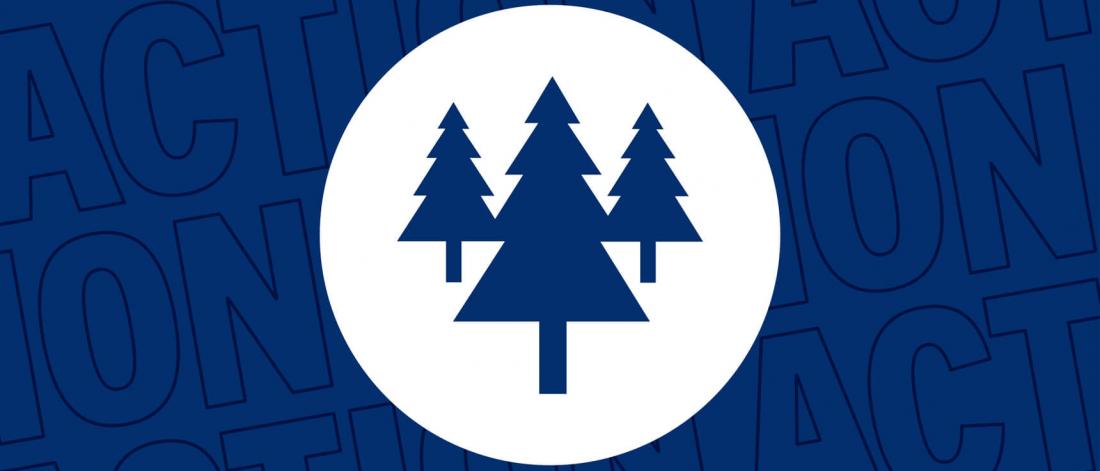Land
Learn more about actions we’re taking and the pathways we need to ensure that our land use is efficient, respectful and sustainable — including preserving and increasing our green spaces to remove carbon and close our emissions gap.

Climate Action Plan
As our campuses grow over time, the campus master plans promote more dense, urban development to ensure that future building, transportation and open space developments create a more walkable, vibrant campus community — one that supports active modes of transportation while preserving and enhancing greenspace and native ecosystems.
Indigenous Planning and Design Principles show us that as stewards of the land, we must acknowledge the interdependent and interconnected nature of a place. Effective holistic planning recognizes that all components of a place — land, water, transportation networks, buildings, infrastructure, open spaces, and the people that inhabit it — are linked in complex ways.
We will develop and utilize our campus lands to help to remove or offset emissions to achieve net zero beyond the action plans for energy and buildings, transportation and waste, including our agricultural educational and research areas.
ACT
UM’s Climate Action Plan embraces the community’s willingness and desire to work together to see change. To achieve the action goals, everyone has a role to play. Here are some ways you can help us meet our climate action goals for land.
Baseline

Highlights
UM’s commitment to the land and spaces on our campuses includes work done over the past number of years and continuing today.
2016
- Indigenous Planning and Design Principles completed and adopted.
- Visionary (re)Generation Master Plan approved for Fort Garry campus.
2017
- Updated tree inventory completed for Fort Garry campus.
2018
- Biodiversity Baseline Study and Assessment (PDF) of the university’s riparian forest completed.
- Implementation of a strategy to reclaim wood on campus.
2019
- Exterior Space Inventory completed for the Fort Garry Campus.
- Implementation of a Native Re-Vegetation Strategy.
2020
- The Cultural landscape of the Fort Garry Campus (PDF) is published.
2023
- Urban Forestry Management Strategy completed.
Big moves Pathway actions for land
How we monitor and manage the landscape can have a great impact on carbon storage and sequestration both directly and indirectly. Use of native vegetation reduces emissions related to maintenance and conserves water resources, while storing carbon within their root systems.
Forestry management
Effective forestry management ensures the long-term longevity of our campus canopy, providing many aesthetic and environmental benefits. The urban forest impacts energy usage by reducing the urban heat-island effect, lowering the need for cooling in warmer months while also providing shelter in colder months.
What we're doing:
- Creating a UM Forestry Management Strategy to identify opportunities for planting and strategies for effective management
- Integrating of a tree inventory to monitor the overall health of the campus canopy
- Reclaimed wood inventory ensures any trees needing to be removed are salvaged and prepared for re-use on campus
Incorporating native vegetation
Native vegetation are more adapted to local climate and soil conditions and contribute to a healthy ecosystem. To increase biodiversity on campus and reflect the environmental history of the lands where we are located, UM has begun to integrate native grass, shrub and tree species into various areas of the campus that have typically been dominated by conventional turf and ornamental vegetation.
What we're doing:
- Implementing a native re-vegetation strategy that uses a native grass seed mixture and tree palette for areas of re-planting
- Indigenous place-making initiatives that illustrate the environmental and cultural histories of the campus lands and highlight Traditional Knowledge related to native species found on campus
Environmental monitoring
To better preserve and enhance the campus landscape, it is important to monitor land-use and forestry changes at a high level. Through the implementation of an Exterior Space and Campus Tree Inventory for the Fort Garry campus, we can look for indicators of success or concern that can be used to inform planning, design, or management frameworks.
What we're doing:
- Completed biodiversity baseline that identifies threats and opportunities to enhance our native ecosystems
- Implementing an exterior space inventory that tracks changes in greenspace area and areas of native vegetation over time
Did you know?
-
18% tree coverage
The University of Manitoba’s tree canopy covers approximately 56 hectares or 18% of the Fort Garry campus
-
1,363 metric tons
Planted trees store 1,363 metric tons and sequester 32 metric tons of carbon per year
-
$14 million in trees
Planted trees at the Fort Garry campus are valued at over $14 million
-
90 logs reclaimed
Approximately 90 logs have been reclaimed since 2018. All logs are milled, stacked, stickered and stored for reuse at the Fort Garry campus
You may also be interested in:
Contact us
Climate Action Plan
Office of Sustainability
152 Physical Plant Building
89 Freedman Crescent
University of Manitoba (Fort Garry campus)
Winnipeg MB R3T 2N2





